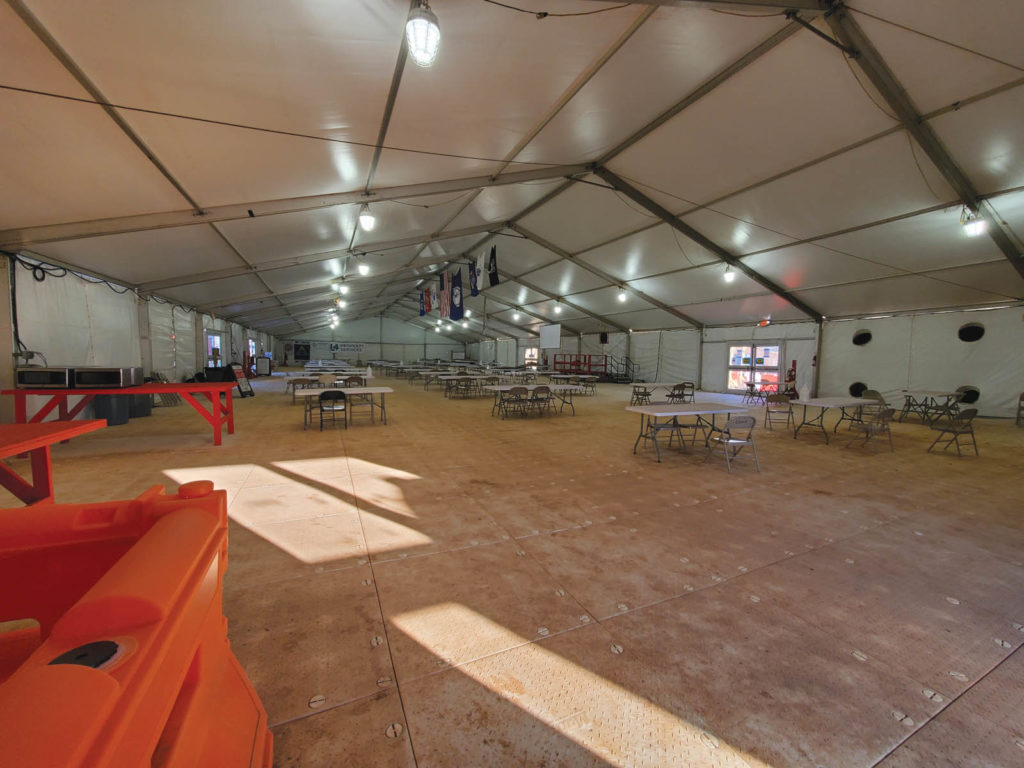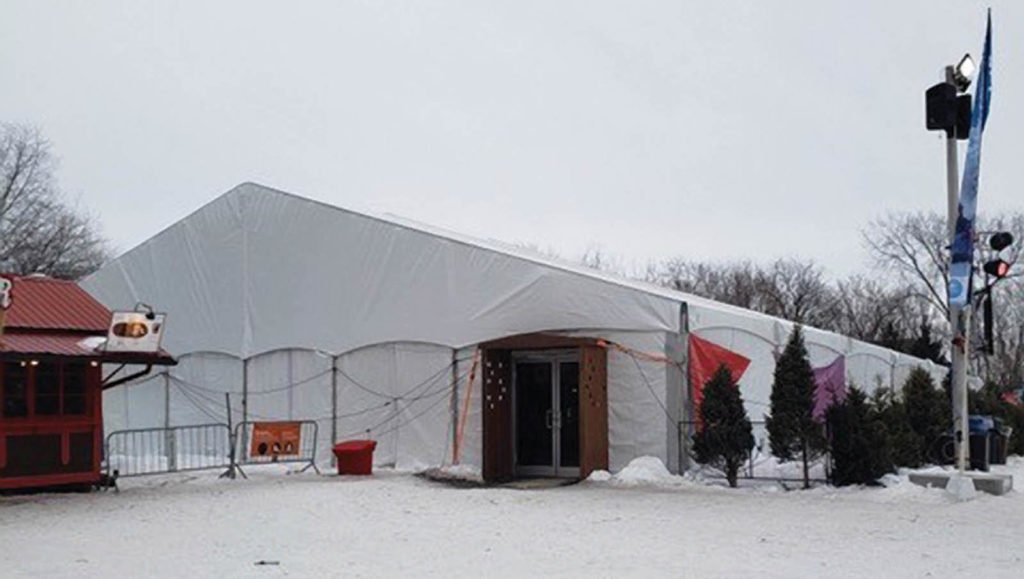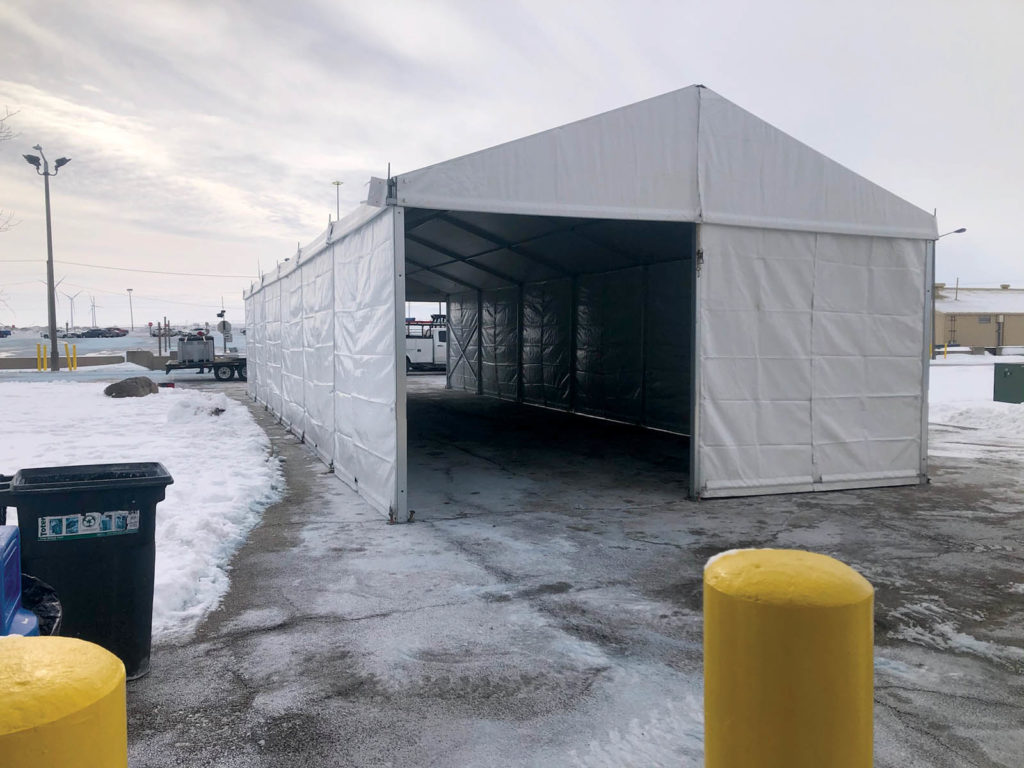Most news having to do with climate change focuses on climbing global temperatures. But those in the tenting industry who work in northern climates know that shifts in weather patterns also bring unexpected cold—and that working in frigid temperatures is simply part of the business.
For example, in January 2019, according to the Yale Climate Connections newsletter, a cold air outbreak swept across portions of the northern Plains and midwestern U.S. During that time, temperatures plunged below -40° F, with wind chills reaching more than -60° F. Even with that extreme, though, the average temperature for the month in the U.S. was nearly three degrees warmer than normal, and the month was also the globe’s third-warmest January on record.
And, of course, the winter of 2020–21 also brought with it the need for tents to deliver COVID-related services, a situation that could possibly repeat itself in the winter of 2021–22. The same goes for tents put up for outdoor dining and other consumer services, allowed in some municipalities where indoor services have been restricted or prohibited.
For this article, we talked to five companies that do tented events in the cold, and each has a slightly different take on the task. But all agree on one thing: “Tenting in the winter is a huge challenge.”
Not warm, but business grew
In many winters, Joe Hynes, owner of Northeast Tent Productions in Stamford, Conn., would see an increase in tented event business if the weather happened to be unusually warm. This past winter was just the opposite—the weather was colder but business boomed. Besides erecting tents for schools, hospitals and other facilities, Northeast catered to residents who wanted tents that could be used for Thanksgiving and other holiday gatherings while still following local ordinances.
“We could provide a bar or food service outside to give them a little more room,” Hynes says.
The wild card in winter tenting is not necessarily the temperature, according to Hynes—it’s the precipitation. “If it snows, for example, any tent setup is going to require a lot of maintenance,” he says. “You really have to plan for the worst-case scenario and then price for that as well.”
A significant amount of the cost involved in winter tenting, Hynes says, is the fuel that’s required to heat the tents. “This past year, the cost of heating tents for our restaurants could get pretty cost prohibitive,” he explains. “You have to have the heat on all the time.”
In most cases, he adds, propane-fired heats are used for cold-weather tented events, but Northeast sometimes bring in vendors who can do electric heat for smaller jobs.
Navi-Trac® frame tents are usually the choice for winter installations by Northeast. “It’s got a little more strength, especially in smaller sizes,” Hynes says. “Pulling the fabric through a keder seems to be work out better as opposed to a small frame where the top can get really stiff in the cold.”

Tent canvas in the cold
“In a lot of places, you’d never hear of a tent being erected for a winter funeral, but we’ve done them,” says Kathy Cardinal, owner of Cardinal Events in Mack, Colo., a company near the Utah border.
Cardinal Events does a number of tented winter events each year, Cardinal says. “It’s a huge challenge, because when the canvas gets cold, it doesn’t want to stretch, it doesn’t want to move, it doesn’t want to do anything.”
Like some of the other company owners interviewed, Cardinal says that it’s a real advantage to either heat up the tent canvases before they are taken outside or keep them in a heated area.
She says her company also must charge higher prices in winter than in the warmer months because of the extra difficulties.
“We do charge twice the usual price, sometimes two and a half times, when we’re doing winter setups since they’re so difficult,” says Cardinal. “Part of it is that usually when we do those types of installs, I have somebody on site at all times. That way if it does snow or if there is some weather-related problem, they can take care of it.”

Everything more difficult
Keven Denney, president at Lafayette Tents & Events in Lafayette, Ind., agrees with Hynes and Cardinal on the increased difficulty of tenting in low temperatures. “The cold weather makes everything exponentially more difficult,” he says. “The installers have more layers on, and the fabric is cold and stiff.
“If we can, we try to have a building close by or on the site that we can use to keep the fabric warm, and then when it’s ready to be put on, you can bring it out one piece at a time,” Denney explains. “It takes longer, but in the end, it actually saves you time because cold material is not fun to deal with.”
Having a business that centered around events was not ideal during the pandemic, but Lafayette was able to transition into COVID testing, including a massive drive-through tent structure in the parking lot at Milwaukee’s American Family Field (formerly Miller Park).
“Wherever anyone needs a tent in winter, we do it,” Denney says. “But if the client doesn’t want to heat the tent, we’re not going to provide tents for them because our tents are not snow-loaded—they have to be heated.”
“You have to be really careful with the heat, because it gets expensive for the client,” Denney explains, “especially for tents like the one for the ballpark, because we had to pump heat through that thing 24/7.”
Winter work common in Quebec
“We’re in Quebec and Montreal, so if you don’t do winter tents, you don’t do a lot of tents,” says Nelson Grandchamp, production manager of Grandchamp Structure Design in Montreal, Que., Canada, which rents tents and specializes in manufacturing self-supporting solid-structure tents up to 140 feet wide.
The company does significant winter tenting for snow carnivals, festivals and temporary storage buildings, Grandchamp says, using structures that are sometimes heated and sometimes not, but which must be approved for snowload. “And you need a special kind of fabric that is designed to be good in the winter,” he adds. “We prefer coated fabric because it’s more flexible. Stiffer fabrics, such as clear windows and clear tops, just can’t be used in the winter.”
For tents that are heated, Grandchamp explains, “the heat is on constantly. There’s no insulation on a winter tent.”
In recent years, Grandchamp notes, there’s been a new kind of demand for winter tenting. “Construction companies will have us put up a tent and heat it up, and then they can pour concrete under it for their construction work. They don’t have snow on everything, and since it’s heated up, the workers are warm inside.”
Winter slows the process
Regal Tents and Structures, based in Stoney Creek, Ont., Canada, doesn’t mess around when it comes to constructing tents in cold weather. According to vice president Michelle McCulloch, the company has been called upon to build tenting for the National Basketball Association All-Star Game in Toronto, the National Hockey League All-Star Game in Montreal and other similar high-profile events, and the cold weather always provides a challenge.
“When we did the NHL game, we had to use a laser level to make sure the floor was level, and the liquid in the laser levels kept freezing,” she said. “When we were taking the tent down, there was a blizzard and as we lowered the tent, the arches kept disappearing in the snow.”
Regal does a lot of tenting for new construction, allowing concrete to be poured under the heated fabric. “If we put up a clearspan tent and they heat it, they’re able to pour that foundation and get a jumpstart on the construction timeline,” McCulloch says. “One job we did was in the middle of Saskatchewan and we put up a 50-by-55-meter structure that was up for about six weeks. They poured the foundation and started some of the walls in February to meet their construction deadlines.”
The company uses white vinyl for winter tents that is rated at -40° C, so it doesn’t crack in the cold.
“Tenting in the winter is a lot slower process,” McCulloch notes. “You have to allow for extra days because you’ve got to take your time and you’re not moving as quickly.”
Jeff Moravec is a freelance writer based in Brooklyn Park, Minn.
SIDEBAR: To stake or not to stake?

There’s always a decision to be made about how to erect tents—stakes, ballast, etc.—no matter what time of year. But erecting a tent in the winter can be a special challenge, especially in areas where the ground is as solid as an ice block.
Joe Hynes, owner of Northeast Tent Productions in Stamford, Conn., says his company generally uses a combination of stakes and ballast, depending on the site. “Typically, the ground is not going to get so solid that we can’t get a stake in,” he says.
Lafayette Tents & Events in Lafayette, Ind., will stake “99 percent of our structures, whether it’s frozen or not,” says owner Keven Denney. “We use a pneumatic device that hooks up to our skid steerer and we really haven’t experienced any issues where we couldn’t put a stake in the ground.”
But, he says, “if the client wants to use ballast, we will absolutely use ballasting. I just prefer to stake things.”




Leave A Comment